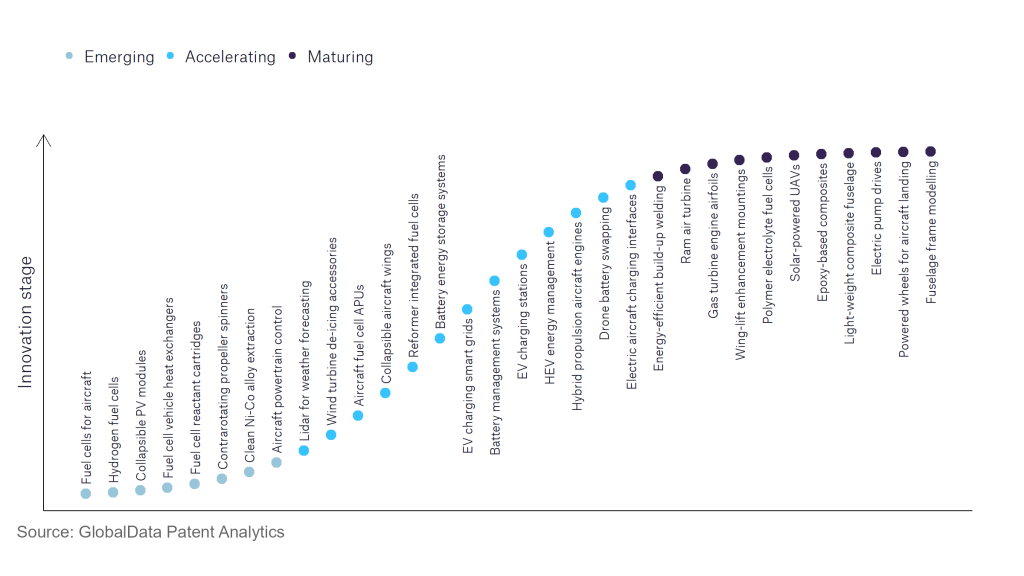The aerospace and defence industry continues to be a hotbed of innovation, with activity driven by the need to lower operational costs, consumer trends, and electrification, and growing importance of technologies such as hydrogen and electric aircraft and advanced materials. In the last three years alone, there have been over 174,000 patents filed and granted in the aerospace and defence industry, according to GlobalData’s report on Environment Sustainability in Aerospace, Defence & Security: Wing-lift enhancement mountings. Buy the report here.
However, not all innovations are equal and nor do they follow a constant upward trend. Instead, their evolution takes the form of an S-shaped curve that reflects their typical lifecycle from early emergence to accelerating adoption, before finally stabilising and reaching maturity.
Identifying where a particular innovation is on this journey, especially those that are in the emerging and accelerating stages, is essential for understanding their current level of adoption and the likely future trajectory and impact they will have.
180+ innovations will shape the aerospace and defence industry
According to GlobalData’s Technology Foresights, which plots the S-curve for the aerospace and defence industry using innovation intensity models built on over 262,000 patents, there are 180+ innovation areas that will shape the future of the industry.
Within the emerging innovation stage, hydrogen fuel cells, aircraft powertrain controls, and fuel cells for aircraft are disruptive technologies that are in the early stages of application and should be tracked closely. EV charging stations, hybrid propulsion aircraft engines, and electric aircraft charging interfaces are some of the accelerating innovation areas, where adoption has been steadily increasing. Among maturing innovation areas are fuselage frame modelling and powered wheels for aircraft landing, which are now well established in the industry.
Innovation S-curve for environmental sustainability in the aerospace and defence industry

Wing-lift enhancement is a key innovation area in environmental sustainability
Incremental advances to aircraft wing design, along with entirely novel designs, can allow aircraft to increase their aerodynamic efficiency, increasing lift, reducing drag, and thus improving fuel consumption performance.
GlobalData’s analysis also uncovers the companies at the forefront of each innovation area and assesses the potential reach and impact of their patenting activity across different applications and geographies. According to GlobalData, there are 10+ companies, spanning technology vendors, established aerospace and defence companies, and up-and-coming start-ups engaged in the development and application of wing-lift enhancement.
Key players in wing-lift enhancement – a disruptive innovation in the aerospace and defence industry
‘Application diversity’ measures the number of different applications identified for each relevant patent and broadly splits companies into either ‘niche’ or ‘diversified’ innovators.
‘Geographic reach’ refers to the number of different countries each relevant patent is registered in and reflects the breadth of geographic application intended, ranging from ‘global’ to ‘local’.
Patent volumes related to wing-lift enhancement
Source: GlobalData Patent Analytics
Amongst aerospace and defence companies, Textron is the leading patent filer in wing-lift enhancement. Textron is heavily involved in the production of both fixed-wing and rotorcraft platforms for both defence and commercial customers through its Beechcraft, Textron Bell, Pipistrel, and Cessna subsidiaries. In recent years, the company has invested in delivering incremental advances to wing design in order to improve aerodynamic performance. For instance, improvements to Hawker 750 winglets have delivered operators a 5% improvement in time to climb and a 4% range increase at long-range cruise settings. These benefits translate into lower fuel consumption and operational costs for clients.
Other key patent filers amongst aerospace and defence companies in wing-lift enhancement include Lockheed Martin, Airbus, Boeing, and Leonardo.
In terms of application diversity, Raytheon Technologies holds the most widely applicable patents, whilst Moog and Leonardo come in at second and third, respectively. Regarding geographic reach, Leonardo leads the way, followed by Moog, and Deutsches Zentrum fur Luft.
Leading aircraft producers such as Airbus and Boeing are actively pursuing the development of entirely novel wing/ body designs in order to improve the aerodynamic properties of their aircraft. Airbus is developing a blended wing-body design for one aircraft under its ZEROe programme, whilst Boeing has explored the development of a truss-based wing design, titled the Transonic Truss-Braced Wing (TTBW). Through enhancing the amount of lift generated by aircraft aerodynamic surfaces, it is possible to reduce the amount of fuel required. Going forward into a market that is increasingly defined by both consumer expectation and government regulation demanding improved sustainability performance, developments such as these will be essential for firms active in the aerospace and defence industry.
To further understand the key themes and technologies disrupting the aerospace and defence industry, access GlobalData’s latest thematic research report on Defence.
Data Insights
From

The gold standard of business intelligence.
Blending expert knowledge with cutting-edge technology, GlobalData’s unrivalled proprietary data will enable you to decode what’s happening in your market. You can make better informed decisions and gain a future-proof advantage over your competitors.



